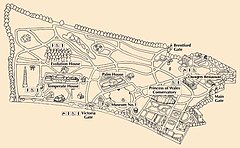Kew Gardens
| Kew Gardens | |
|---|---|

Kew Gardens Temperate House from the Pagoda
|
|
| Type | Botanical |
| Location | London Borough of Richmond upon Thames, England |
| Coordinates | 51°28.480′N 0°17.728′W / 51.474667°N 0.295467°WCoordinates: 51°28.480′N 0°17.728′W / 51.474667°N 0.295467°W |
| Area | 121 hectares (300 acres) |
| Opened | 1759 |
| Visitors | more than 1.35 million per year |
| Species | > 30,000 |
| Website | www |
|
UNESCO World Heritage Site
Kew Gardens |
|
| Name as inscribed on the World Heritage List | |
 |
|
| Type | Cultural |
| Criteria | ii, iii, iv |
| Reference | 1084 |
| UNESCO region | Europe and North America |
| Inscription history | |
| Inscription | 2003 (27th Session) |
Kew Gardens is a botanical garden in south-west London and houses the "largest and most diverse botanical and mycological collections in the world". Founded in 1840, from the exotic garden at Kew Park in the London Borough of Richmond upon Thames, UK, its living collections include more than 30,000 different kinds of plants, while the herbarium, which is one of the largest in the world, has over seven million preserved plant specimens. The library contains more than 750,000 volumes, and the illustrations collection contains more than 175,000 prints and drawings of plants. It is one of London's top tourist attractions and is a World Heritage Site.
Kew Gardens, together with the botanic gardens at Wakehurst Place in Sussex, are managed by the Royal Botanic Gardens, Kew (brand name Kew), an internationally important botanical research and education institution that employs 750 staff, and is a non-departmental public body sponsored by the Department for Environment, Food and Rural Affairs.
The Kew site, which has been dated as formally starting in 1759, though can be traced back to the exotic garden at Kew Park, formed by Lord Capel John of Tewkesbury, consists of 121 hectares (300 acres) of gardens and botanical glasshouses, four Grade I listed buildings and 36 Grade II listed structures, all set in an internationally significant landscape.
Kew Gardens has its own police force, Kew Constabulary, which has been in operation since 1847.
Kew, the area in which Kew Gardens are situated, consists mainly of the gardens themselves and a small surrounding community. Royal residences in the area which would later influence the layout and construction of the gardens began in 1299 when Edward I moved his court to a manor house in neighbouring Richmond (then called Sheen). That manor house was later abandoned; however, Henry VII built Sheen Palace in 1501, which, under the name Richmond Palace, became a permanent royal residence for Henry VII. Around the start of the 16th century courtiers attending Richmond Palace settled in Kew and built large houses. Early royal residences at Kew included Mary Tudor's house, which was in existence by 1522 when a driveway was built to connect it to the palace at Richmond. Around 1600, the land that would become the gardens was known as Kew Field, a large field strip farmed by one of the new private estates.
...
Wikipedia

